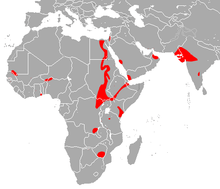Egyptian tomb bat
| Egyptian tomb bat | |
|---|---|
 | |
| Scientific classification | |
| Kingdom: | Animalia |
| Phylum: | Chordata |
| Class: | Mammalia |
| Order: | Chiroptera |
| Family: | Emballonuridae |
| Genus: | Taphozous |
| Species: | T. perforatus |
| Binomial name | |
| Taphozous perforatus É. Geoffroy, 1818 | |
 | |
| distribution | |
The Egyptian tomb bat (Taphozous perforatus) is a species of sac-winged bat in the family Emballonuridae.[1] It is a medium- to large-sized bat with a mass of approximately 30 g (1.1 oz).[2] It is an aerial insectivore, foraging in open space.[2] Based on individuals captured in Ethiopia, it is thought to feed predominantly on Lepidoptera, but is also known to feed on Isoptera, Coleoptera and Orthoptera.[2]
Habitat
It is found in Benin, Botswana, Burkina Faso, Democratic Republic of the Congo, Djibouti, Egypt, Ethiopia, Gambia, Ghana, Guinea-Bissau, India, Iran, Kenya, Mali, Mauritania, Niger, Nigeria, Pakistan, Saudi Arabia, Senegal, Somalia, Sudan, Tanzania, Uganda, and Zimbabwe. Its natural habitat is dry savanna.[3]
Reservoir of MERS-CoV
An isolate of the MERS-CoV from the first patient identified was found in an Egyptian tomb bat near the victim's home in Saudi Arabia. The isolate, found in a fecal pellet from the bat, was found to be a 100% match with the London victim.[4]
References
- ↑ Mickleburgh, S., Hutson, A. & Bergmans, W. 2004. http://www.iucnredlist.org/search/details.php/21463/all Taphozous perforatus.
- 1 2 3 Monadjem; et al. (2010). Bats of Southern and Central Africa. Johannesburg: Wits University Press.
- ↑ Skinner, J. D.; Chimimba, Christian T., eds. (2011). The Mammals of the Southern African Sub-region. Cambridge University Press. pp. 276–278.
- ↑ "MERS-CoV found in bat; hunt for other sources goes on | CIDRAP". Cidrap.umn.edu. 2013-08-21. Retrieved 2013-09-15.
